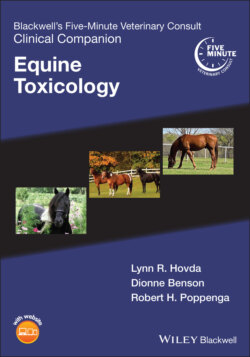Читать книгу Blackwell's Five-Minute Veterinary Consult Clinical Companion - Группа авторов - Страница 60
ОглавлениеChapter 5 Compounded Medication
The use of compounded medication is an area of much confusion in veterinary medicine. The law in this area is ever‐changing and subject to discretionary enforcement. Legitimate veterinary compounding is an important part of an equine practitioner’s arsenal to treat horses.
What is Compounding?
There are four types of substances that must be discussed to understand compounding:
Brand name medication. These are medications developed by pharmaceutical companies and approved through the FDA drug process. Ketofen® and GastroGard® are examples of brand name medications. These medications need to successfully complete safety and efficacy trials and then each batch is regulated to ensure purity.
Generic medication. These are developed by pharmaceutical copies as mimics of previously approved brand name medications. These are developed when the patent on a brand name medication expires. These medications still must satisfy FDA regulations and are subject to FDA testing. These are not considered to be compounded medications.
Compounded medication. These are created when an approved (generic or brand name) medication is customized to meet the needs of a specific patient for a specific diagnosis. The following are examples of legal compounding:Adding flavoring and creating a paste from FDA‐approved products such as phenylbutazone pills, etc.Combining FDA‐approved version of hyaluronic acid and corticosteroids prior to intra‐articular administration.Mixing FDA‐approved versions of butorphanol and detomidine prior to intravenous administration.
Illegal new medication. Mixing of multiple substances and marketing it as a new product to treat or prevent disease is considered the creation of an illegal new medication. This type of activity lacks research regarding the efficacy and effects of mixing two products together. They could potentially inactivate one another, increase the reaction when mixed, or, in the cases of some combinations, create a toxic product. One example of an illegal new medication is misoprostol mixed with bulk omeprazole. These types of products have been marketed by companies directly to trainers for gastric ulcers.
Toxicity and Compounding (see Figs 5.1–5.3)
Legal and illegal instances of compounding as well as the use of illegal new medications do not come without significant risk to the horse. In several instances, administration of improperly compounded medication has been associated with death. For example:
Compounded clenbuterol linked to three horse deaths in Louisiana.
Compounded pyrimethamine and toltrazuril sold in Pennsylvania and Kentucky associated with at least seven horse deaths.
Compounded selenium administered to 21 polo ponies that died in Florida.
Thirty‐two human deaths associated with methylprednisolone acetate that was compounded in non‐sterile conditions.
These are just examples of fatalities that have occurred after the administration of a compounded medication.
Why Extra Caution is Needed for Compounded Products
When compared to FDA‐approved generic or brand name medications, compounded medications inherently have higher risk. FDA‐approved medications (including generic medications) are required to prove:
Purity.
Efficacy.
Consistent concentration.
Stability.Fig. 5.1. Compounded substance labeled Equine Monster Energy. Interestingly, this product also violates copyright law due to the image on the bottle.Source: Photo courtesy of Dionne Benson.Fig. 5.2. Compounded substance labeled Tourniquet.Source: Photo courtesy of Dionne Benson.Fig. 5.3. Compounded substance labeled omeprazole/ranitidine.Source: Photo courtesy of Dionne Benson.
These requirements are not imposed for compounded medications. In fact, the FDA involvement in compounded medications is often limited to investigation after incidents occur such as those listed above.
Additionally, it is important to consider that the use of compounded medications for cost‐saving purposes is prohibited under FDA regulation. For example, purchasing compounded ketoprofen to avoid paying for brand name Ketofen® is illegal.
Finally, practitioners should know that the use of compounded medication is often specifically excluded on professional liability insurance. In other words, if you are treating a horse and prescribe a compounded medication and something goes wrong, your insurance company may not have to defend you from or indemnify you for any liability.
The safest course of action is to avoid the use of compounded medication altogether whenever possible and find a reputable compounder to use in those instances where it is the only alternative.
Abbreviations
See Appendix 1 for a complete list.
Internet Resources
1 American Association of Veterinary Medicine, Veterinary Compounding, undated. Available at https://www.avma.org/resources‐tools/avma‐policies/veterinary‐compounding (accessed February 8, 2021).
2 Thomas K. Polo ponies were given incorrect medication. The New York Times, April 23, 2009. Available at: https://www.nytimes.com/2009/04/24/sports/othersports/24polo.html (accessed February 5, 2021).
3 United States Food and Drug Administration. Compounded Unapproved Animal Drugs from Rapid Equine Solutions Linked to Three Horse Deaths, July 23, 2019. Available at: https://www.fda.gov/animal‐veterinary/cvm‐updates/compounded‐unapproved‐animal‐drugs‐rapid‐equine‐solutions‐linked‐three‐horse‐deaths (accessed February 5, 2021).
4 United States Food and Drug Administration. FDA Alerts Horse Owners and Veterinarians About Adverse Events Associated with Certain Unapproved Compounded Drugs in Horses, May 15, 2014. Available at: https://wayback.archive‐it.org/7993/20170406075905/https:/www.fda.gov/AnimalVeterinary/NewsEvents/CVMUpdates/ucm397345.htm (accessed February 5, 2021).
Suggested Reading
1 Thompson J, Mirza M, Barker S, et al. Clenbuterol toxicosis in three quarter horse racehorses after administration of a compounded product. J Am Vet Med Assoc 2011; 239:842–849.
2 Barlas S. Deaths from contaminated methylprednisolone highlight failures of compounding pharmacies: Less hospital access to outside vendors and more visits from state pharmacy boards. P T. 2013; 38(1):27–57.
Author: Dionne Benson, DVM, JD
Consulting Editor: Dionne Benson, DVM, JD
